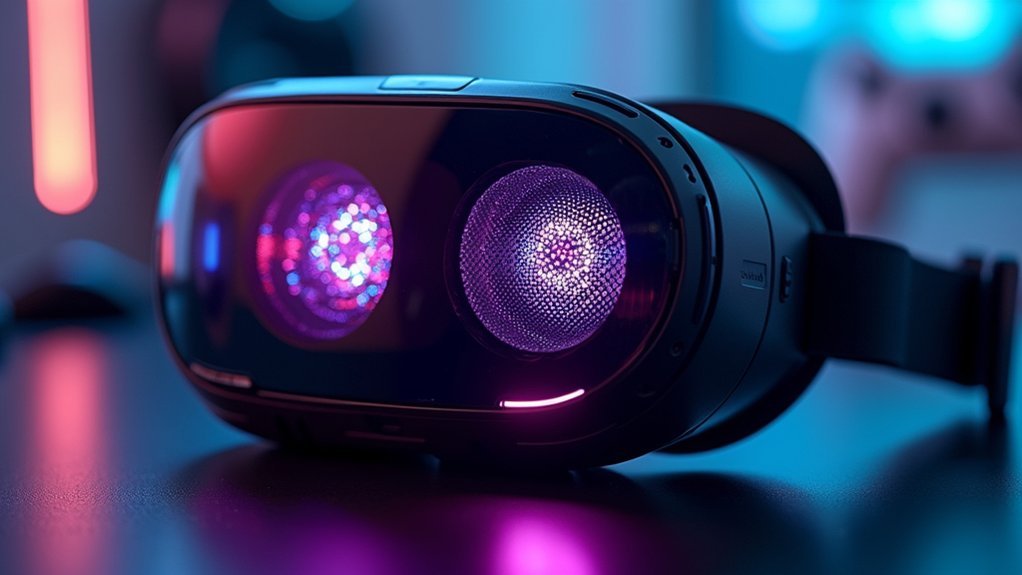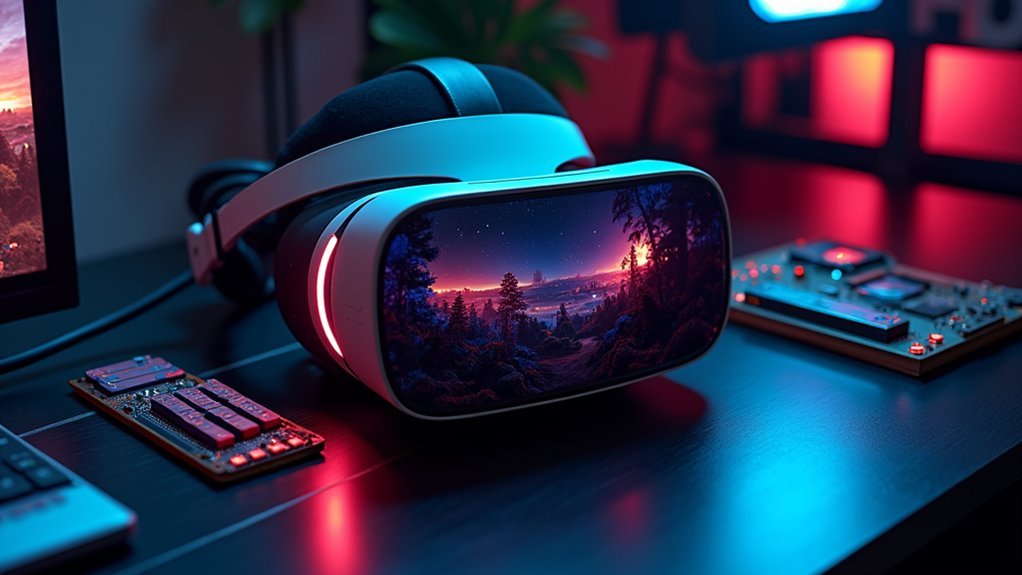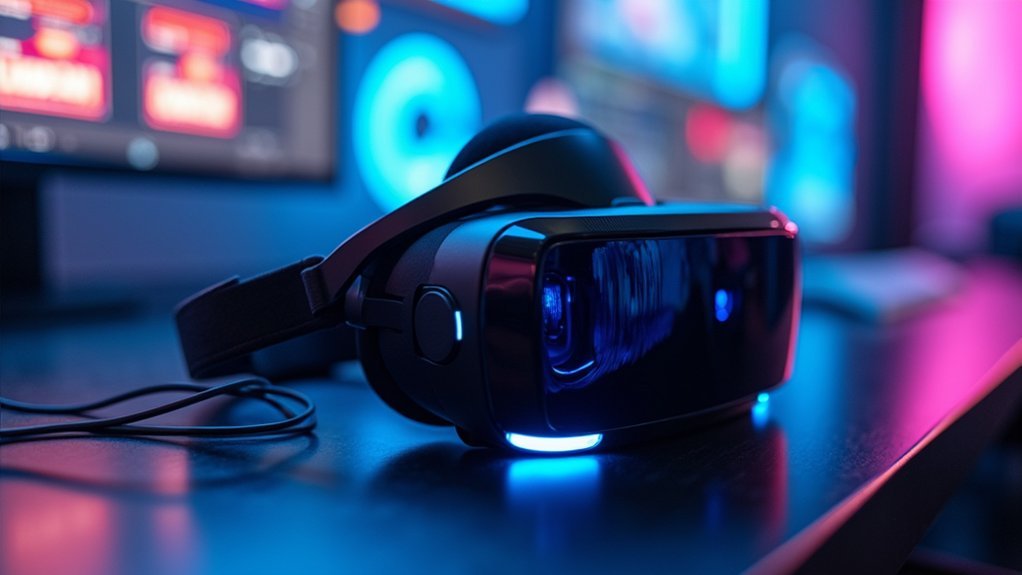You’ll want a VR headset with at least 2064 x 2208 pixels per eye and 90Hz refresh rate to avoid motion sickness. Look for motion-to-photon latency under 20 milliseconds, 110-130 degree field of view, and inside-out tracking for accuracy. Choose headsets under 500 grams with quality padding for comfort during extended sessions. Consider wireless connectivity like Wi-Fi 6E and approximately two hours of battery life. These core specifications will transform your virtual gaming experience into something truly extraordinary.
Display Resolution and Pixel Density Requirements

When choosing a VR headset for gaming, you’ll need at least 2064 x 2208 pixels per eye to achieve sharp visuals and minimize the distracting pixelation that can break immersion.
Higher pixel density directly impacts your gaming experience by reducing the Screen Door Effect—those visible grid lines that remind you you’re wearing a headset. Premium headsets like the HTC Vive Pro 2 offer 2448 x 2448 pixels per eye, delivering exceptional visual clarity that makes virtual worlds feel more realistic.
However, display resolution must work alongside refresh rate for peak performance. You’ll want 90Hz or higher to maintain smooth motion during fast-paced gaming sessions.
Higher refresh rates are essential for VR gaming—aim for 90Hz minimum to prevent motion blur and maintain immersion during intense action sequences.
Remember that higher resolutions demand powerful GPUs to sustain performance without compromising frame rates.
Refresh Rate and Frame Rate Specifications
You’ll need to understand how refresh rate and frame rate work together to create smooth VR experiences that won’t make you sick.
Your headset’s refresh rate determines how many times per second the display updates, while frame rate measures how quickly your graphics card renders new images.
Getting these specifications right impacts everything from motion smoothness to the advanced technologies that prevent visual artifacts during fast movements.
Optimal Refresh Rate Standards
Why does refresh rate matter so much in VR gaming?
You’ll want to target a suitable refresh rate of at least 90Hz for your VR headsets to prevent motion sickness and guarantee an immersive experience. High refresh rate displays minimize latency between your movements and visual output, reducing that queasy feeling during intense gaming sessions.
Most developers recommend 90Hz as the minimum standard, but you’ll get even smoother visuals with 120Hz models like the Valve Index. Higher refresh rates deliver more fluid gameplay, especially during fast-paced scenarios with rapid movements.
Frame Rate Performance Impact
Frame rate performance directly determines whether you’ll experience seamless VR gameplay or frustrating stutters that break immersion. You need consistent frame rates of 90 FPS or higher to maintain fluid interactions with virtual environments.
When your headset can’t deliver stable performance, you’ll encounter stuttering and lag that disrupts your visual experience and increases latency.
Frame drops are particularly problematic in VR because they can cause disorientation or nausea. Your headset’s refresh rate works hand-in-hand with frame rate performance – even high-end headsets supporting 144Hz won’t deliver immersive VR experiences if your system can’t maintain matching frame rates.
You must verify your hardware can consistently output frames that match your headset’s refresh rate capabilities for peak performance.
Motion Smoothness Technology
When motion smoothness technology combines with ideal refresh rates, your VR headset transforms choppy visuals into fluid, natural movement that keeps you fully immersed.
You’ll need at least 90Hz refresh rate for comfortable immersive VR experiences, though premium headsets like the Meta Quest 3 deliver up to 120Hz for enhanced visual fluidity.
Your frame rate must match your headset’s refresh rate to prevent stuttering and tearing that’ll break immersion in virtual environments.
Motion tracking accuracy depends heavily on this synchronization between refresh and frame rates.
When they’re misaligned, you’ll experience jarring visual artifacts that can trigger motion sickness.
Higher refresh rates reduce latency, ensuring your head movements translate instantly into responsive visuals that maintain the illusion of presence in virtual worlds.
Field of View Coverage and Visual Immersion
Since your sense of presence in virtual worlds depends heavily on how much you can see, field of view coverage becomes one of the most critical specs when choosing a VR headset. A broader field of view, typically around 110 to 130 degrees, dramatically enhances visual immersion by expanding your peripheral vision.
When combined with higher resolution displays and ideal refresh rates, you’ll experience:
- Reduced screen door effect for sharper, more realistic imagery
- Enhanced spatial awareness through inside-out tracking technology
- Smoother gameplay with 90Hz or higher refresh rates
- More natural peripheral vision that mimics real-world sight
- Greater sense of presence during fast-paced gaming scenarios
The Meta Quest 3’s 2064 x 2208 pixels per eye exemplifies how proper FOV paired with advanced specs creates a truly immersive experience.
Tracking System Capabilities and Accuracy
How precisely can your VR headset translate real-world movements into the virtual environment? Your tracking systems determine whether you’ll enjoy seamless immersive gaming or struggle with motion sickness from poor accuracy.
Modern headsets offer two main tracking approaches. Inside-out tracking uses built-in cameras for convenient setup, while VR Lighthouses provide external sensors requiring more configuration. Both systems support 6DoF movement tracking, capturing your head and hand positions in all directions.
Low latency remains essential for comfort. Delayed responses between your movements and virtual feedback cause disorientation and nausea. Quality tracking systems maintain minimal delay, ensuring smooth gameplay.
| Tracking Type | Setup Complexity | Accuracy Level |
|---|---|---|
| Inside-Out | Simple | Near-Lighthouse |
| VR Lighthouses | Moderate | Excellent |
| Mobile 3DoF | Minimal | Limited |
| Hybrid Systems | Complex | Superior |
| Basic Gyroscope | None | Poor |
Processor Power and Computing Performance
The processor serves as your VR headset’s engine, determining whether you’ll experience stunning visuals or frustrating lag during gameplay. Your choice between standalone headsets and PC VR headsets greatly impacts the processing power available for your gaming sessions.
The Qualcomm Snapdragon XR2 Gen 2 powers both Quest 3 and Quest 3S models, delivering impressive graphical capabilities that surpass previous generations. For high-end VR experiences, you’ll need substantial computing performance to maintain smooth framerates and prevent motion sickness.
Powerful processors are essential for VR gaming, ensuring smooth framerates and preventing the motion sickness that ruins immersive experiences.
Consider these key processor requirements:
- Standalone headsets rely on built-in chips like Snapdragon XR2+ for all processing.
- PC VR headsets leverage powerful graphics cards like RTX 3080 for peak performance.
- RAM capacity affects multitasking, with 12GB becoming standard for premium models.
- Higher refresh rates demand more computational power.
- Complex environments require advanced processors for seamless rendering.
Memory and Storage Configuration Needs

While processing power drives your VR headset’s performance, memory and storage configuration determines how much content you can access and how efficiently your system handles complex gaming scenarios.
For standalone headsets like the Meta Quest 3, you’ll need at least 8GB of RAM for peak performance, though 12GB provides better multitasking capabilities. Storage options typically range from 128GB to 512GB, but consider your game library size carefully.
If you’re using PC VR headsets, your gaming PC should have 32GB of RAM minimum. NVMe SSDs dramatically improve loading times compared to traditional hard drives.
Since VR games continue growing in size, prioritize systems with expandable storage options. This future-proofs your setup and guarantees you won’t face storage limitations as your content library expands.
Latency and Motion-to-Photon Response Time
When you’re gaming in VR, you’ll notice that even tiny delays between your movements and what you see can break immersion and make you feel sick.
Your headset’s hardware directly impacts how quickly it can track your motion and render the corresponding images, with factors like processing power and sensor quality playing vital roles.
You can markedly reduce VR nausea by choosing headsets that achieve motion-to-photon response times under 50 milliseconds and maintain steady refresh rates above 90Hz.
Measuring Motion Delay
Every millisecond counts when you’re immersed in virtual reality, making motion delay one of the most vital specifications to assess in any VR headset.
Motion-to-photon response time directly impacts your immersive experience, with latency under 20 milliseconds being necessary for comfortable gameplay.
You’ll need to take into account several key factors when measuring motion delay:
- Refresh rate – Higher rates like 90Hz+ reduce perceived latency
- Motion tracking accuracy – Inside-out tracking systems provide near-lighthouse precision
- Processing power – Faster chips minimize computational delays
- Display technology – OLED panels typically respond quicker than LCD
- Sensor quality – Better IMUs detect movement more rapidly
Delays exceeding 20 milliseconds can trigger motion sickness and break immersion, making precise measurement vital for selecting the right headset.
Hardware Impact Factors
Understanding motion delay measurement leads directly to examining the hardware components that create these delays in the first place. Your headset specs directly influence latency and motion-to-photon response time. Higher resolution displays demand more processing power, potentially increasing delays if your hardware can’t handle the workload efficiently.
You’ll want refresh rates of at least 90 Hz to maintain smooth visuals and prevent stuttering that disconnects your actions from what you see.
Inside-out tracking systems greatly reduce latency by eliminating external sensors, allowing your movements to translate immediately into the virtual environment. The processing power of your headset’s chipset determines how quickly it can render frames and respond to input.
When evaluating headset specs, prioritize models that balance high resolution with sufficient processing capabilities to maintain low latency performance.
Reducing VR Nausea
Since your brain expects visual feedback to match physical movements instantaneously, any delay between head motion and display response can trigger motion sickness in VR gaming.
Reducing VR nausea requires optimizing several technical specifications that directly impact your comfort level.
Motion-to-photon response time under 20 milliseconds prevents disorientation, while latency minimization guarantees smooth gameplay.
Here’s what you’ll need:
- Refresh rates of 90Hz or higher reduce motion blur and create smoother visual changes
- Sub-20ms motion-to-photon response time eliminates the disconnect between movement and visual feedback
- Inside-out tracking systems like Meta Quest 3’s technology provide precise movement detection without external sensors
- Wi-Fi 6E connections maintain robust wireless performance for untethered gaming
- Low-latency processing guarantees immediate response to head movements and controller inputs
These specifications work together to create comfortable, nausea-free VR experiences.
Audio Quality and Spatial Sound Features
While visual fidelity often takes center stage in VR discussions, audio quality plays an equally vital role in creating truly immersive virtual experiences. Your VR headset’s spatial sound technology determines how realistically you’ll perceive your virtual environment.
Advanced 3D audio systems like those found in the Meta Quest 3 and PS VR2 create convincing soundscapes that respond to your head movements and accurately simulate distance and directionality.
The Valve Index stands out for its exceptional high-fidelity speakers, delivering crisp sound that’s essential for competitive gaming. Meanwhile, the PS VR2 leverages PlayStation 5’s Tempest Engine to provide omnidirectional audio perception.
Most modern headsets also include integrated microphones for seamless voice chat, ensuring your gaming experience maintains excellent audio quality throughout multiplayer sessions.
Comfort Design and Ergonomic Considerations
When you’re gaming for hours in VR, comfort becomes just as important as visual quality or performance specs.
You’ll want to examine how the headset distributes weight across your head and face, since poor balance can create pressure points that’ll cut your sessions short.
The quality of facial interface padding and adjustable strap systems directly impacts whether you can wear the headset comfortably for extended periods without fatigue or discomfort.
Weight Distribution Balance
Although many gamers focus primarily on display resolution and refresh rates, the weight distribution of your VR headset directly impacts your gaming comfort and endurance.
Poor ergonomic design creates pressure points on your nose and forehead, leading to fatigue during extended sessions.
Proper weight distribution guarantees you’ll enjoy longer gaming without discomfort:
- Choose headsets under 500 grams to prevent neck and shoulder strain
- Look for balanced designs that distribute weight evenly across your head
- Prioritize adjustable straps that accommodate your unique head shape
- Select models with memory foam padding to reduce facial pressure
- Confirm customizable fit options for ideal positioning and stability
The Meta Quest 3 exemplifies excellent weight distribution, featuring improved ergonomic design that enhances comfort for marathon gaming sessions while maintaining performance standards.
Facial Interface Padding
The facial interface padding serves as your headset’s most critical comfort component, creating a soft barrier between your face and the device’s rigid frame.
Quality materials like memory foam or silicone conform to your facial contours, eliminating pressure points during extended gaming sessions and enabling truly immersive experiences.
Proper padding thickness directly affects weight distribution across your face, preventing uncomfortable hotspots that can break your concentration.
Well-designed interfaces also minimize light leakage, maintaining visual immersion by blocking external light from disrupting your field of view.
You’ll need to prioritize hygiene by regularly cleaning your facial interface padding, as accumulated sweat and oils can degrade both comfort and material longevity.
Investing in headsets with removable, washable padding guarantees sustained comfort throughout your VR gaming adventures.
Adjustable Strap Systems
Since headset weight can reach over a pound, adjustable strap systems become your primary defense against neck strain and facial pressure during marathon gaming sessions.
Quality systems like the Meta Quest 3’s tool-free design and Valve Index’s premium straps transform your comfort dramatically. These ergonomic designs distribute weight evenly while maintaining ideal tracking accuracy for an immersive experience.
Key benefits you’ll notice:
- Customizable fit – Adapts to different head shapes and sizes instantly
- Reduced pressure points – Strategic padding protects your nose and forehead areas
- Enhanced stability – Secure positioning improves tracking during active movement
- Quick adjustments – Switch between users without tools or complicated setup
- Better immersion – Proper alignment maintains visual clarity and reduces latency issues
Wireless Connectivity and Battery Life Standards
When you’re shopping for a wireless VR headset, you’ll need to evaluate both connectivity requirements and power limitations that directly impact your gaming experience.
Wireless VR headsets require careful consideration of connectivity needs and battery constraints that shape your entire gaming experience.
Wireless headsets like the Meta Quest 3 demand Wi-Fi 6E routers for peak performance and minimal latency. You’ll get approximately two hours of battery life for gaming sessions, though you can play while charging to extend usage.
Inside-out tracking technology eliminates external sensors while maintaining accuracy, enhancing wireless convenience. A standalone headset offers excellent mobility and freedom of movement, creating more immersive experiences than tethered alternatives.
However, battery life limitations may restrict longer gaming sessions, particularly affecting budget-conscious users. Consider your typical gaming duration when selecting headsets, as power management directly influences your overall VR experience quality.
Frequently Asked Questions
What Are Good Specs for VR Gaming?
You’ll want 2,000×2,000 pixels per eye minimum, 90Hz+ refresh rate, inside-out tracking, 100+ degree field of view, and wireless connectivity with Wi-Fi 6E for peak performance and immersion.
What Is the Best Headset for VR Gaming?
You’ll want the Meta Quest 3 as it’s the best overall VR gaming headset, offering 2064 x 2208 pixels per eye, pancake lenses for comfort, and excellent performance.
What Is a Good Resolution for a VR Headset?
You’ll want around 2000 x 2000 pixels per eye for good VR resolution. Higher resolutions like 2448 x 2448 provide sharper images and reduce visual strain during extended gaming sessions.
How Much RAM Is Recommended for VR?
You’ll want at least 16GB of RAM for VR gaming, though 32GB is ideal for high-end experiences. Insufficient memory causes performance bottlenecks, lower frame rates, and potential motion sickness during gameplay.





Leave a Reply